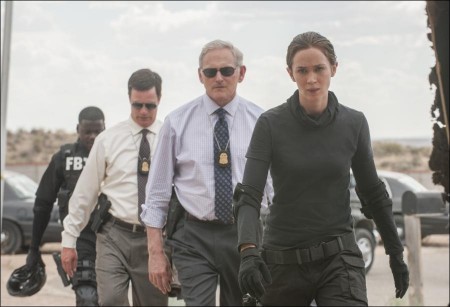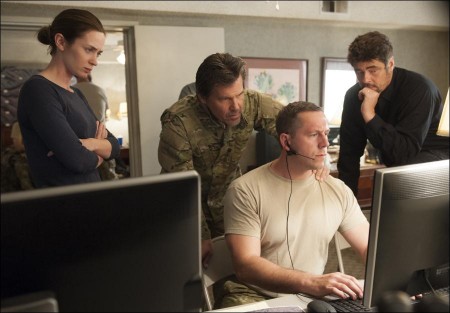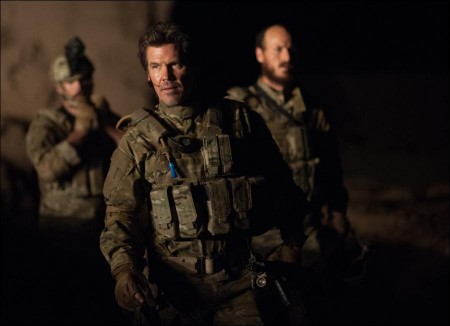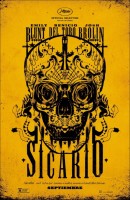Taglines: In Mexico, SICARIO means hitman.
Sicario Movie Storyline. In the lawless border area stretching between the U.S. and Mexico, an idealistic FBI agent [Emily Blunt] is enlisted by an elite government task force official [Josh Brolin] to aid in the escalating war against drugs. Led by an enigmatic consultant with a questionable past [Benicio Del Toro], the team sets out on a journey forcing Kate to question everything that she believes in order to survive.
Sicario is an American action crime thriller film directed by Denis Villeneuve and starring Emily Blunt, Benicio del Toro, and Josh Brolin. Written by Taylor Sheridan, the film is about a principled FBI agent who is enlisted by a government task force to bring down the leader of a powerful and brutal Mexican drug cartel. Sicario was selected to compete for the Palme d’Or at the 2015 Cannes Film Festival. Distributed by Lionsgate, the film began a limited release in the United States on September 18, 2015, prior to a nationwide release on October 2, 2015. The film received three Academy Award nominations: for Best Cinematography, Best Original Score, and Best Sound Editing.

A Borderland Thriller
“You will not survive here. You are not a wolf. This is the land of wolves now.” — Alejandro
From director Denis Villeneuve (Prisoners, Incendies) comes a searing emotional-thriller that descends into the intrigue, corruption and moral mayhem of the borderland drug wars.
When Arizona FBI agent and kidnap-response-team leader Kate Macer (Golden Globe winner Emily Blunt) uncovers a Mexican cartel’s house of death, her shocking find leads to profound consequences on both a personal and global level. Kate is recruited to join a covert black-ops mission headed by a mysterious Colombian operative known only as Alejandro (Academy Award winner Benicio Del Toro, Best Supporting Actor, Traffic, 2000) along with special agent Matt Graver. Even as Kate tries to convince herself she’s on a hunt for justice, she is thrust into the dark heart of a secret battleground that has swept up ruthless cartels, kill-crazy assassins, clandestine American spies and thousands of innocents.
The jagged line of the U.S. and Mexican border is now awash in some of the most pressing questions of our times – drugs, terror, illegal immigration, corruption and an escalating swath of dark crime that has left people on both sides frightened and vigilant. Sicario explores the journey of an intelligence operation that pushes the rules to engage with those who don’t play by any.
Says director Denis Villeneuve, “Sicario takes a powerful look at black-ops operations and the Mexican cartels. But this story is also about America, about the idealism and realism that clash when it comes to dealing with the problems of other countries.”
“It’s a movie about choices,” adds Benicio Del Toro, who dives into one of his most conflicted roles as the equal parts vengeful and tender hit man Alejandro. “It’s tough to say whether any character in Sicario is truly good or bad. Do the means justify the ends? What happens when go into a situation where you want to kill one guy and you kill 20 innocent people? You got the bad guy, but at what cost?”
“Kate is tempted by this world,” says Emily Blunt, who breaks the mold with her portrait of a fierce female character whose life is in jeopardy throughout every second of the film. “She realizes she was barely scratching the surface doing things by the book and now she wants to believe she can do something that will make a real difference. Yet the very idea of no longer following the rules turns Kate’s whole world upside down. Nothing makes sense anymore.”
Josh Brolin, who is known for characters who ply the edges, was intrigued by the movie’s subtext of big questions about values versus security and whether fighting criminals with outlaw behavior darkens hearts beyond repair. “This movie is a human mystery that you get to grab at and put together for yourself,” Brolin says. “It’s a suspenseful and emotional puzzle.”
Building the Story
For screenwriter Taylor Sheridan, a native Texan who grew up traveling south of the border when it was still common to do so, delving into this reality was a personal lure. Sheridan is best known as an actor, specifically for playing Deputy Chief David Hale on “Sons of Anarchy.” With the probing heart of a writer, he felt called to return to his roots to explore what had become forbidden zones over the last decade. He saw that the alluring cross-cultural border of his youth had disappeared.
“I realized that Mexico doesn’t exist anymore, the Mexico someone could just drive down into is gone. It’s become this lawless place,” says Sheridan. “At the same time, I realized I hadn’t seen any movies about how life in northern Mexico has changed, how it has become dominated by drugs and corruption, how the cartels have become militarized and how the machine of the American government has been dealing with these problems that are spilling over the border.”
The more he looked, the more Sheridan saw how much massive profits have trumped human decency, leading to a pressure-cooker atmosphere with disadvantageous impacts. The drug trade has metastasized into a major business – so large that while the flow has at times been momentarily slowed, it has never been in danger of being fully staunched.
As Sheridan started to explore how this state of affairs came to pass, he realized it was like trying to crack open a hornet’s nest. He was walking into a world of classified CIA spy programs, secret DEA deals, cartels who murder journalists researching their operations, and of “houses of death” – residential homes where no families live, but where cartel enemies are routinely stuffed in the walls. It was not your ordinary feature film research.
Sheridan started by poking around sun-seared, dusty border towns in the cactus-splattered Chihuahua Desert. At first he got a lot of radio silence. “I went all along the border. There is no interviewing cartel members, no interviewing government officials. The only way in was to gain the trust of the people who are most affected by it – the migrants who, out of need, cross this border and populate the no man’s land that lies between southern Arizona, New Mexico and northern Mexico,” Sheridan relays. “They were my resources.”
Slowly, a story began to emerge about a side of the war on drugs few ever have seen in the U.S. — the story of a war on drugs that often, in practical terms, becomes a war for drugs, as the powers that be jockey for control of the trade. It was, by necessity, a story full of human ambiguity.
“Crime stories are usually told either from the point of view of the hero or the villain,” Sheridan notes. “This story couldn’t be like that. This is a story in which, even when you think the villain has been caught, you realize the problem hasn’t really been resolved. There will be another villain tomorrow.”
Sheridan was also interested in telling a personal story – a story of how a decent, justice-seeking person is irrevocably haunted by the revelations she finds on the border – and thus was born an unlikely character to take audiences into the looking-glass world of Ciudad Juarez: Kate Macer.
A steely, serious-minded tomboy, she is a woman who has always put her job and country first, who surrounds herself with a kind of shield of aloneness, yet who finds herself more and more emotionally vulnerable as she falls down the hole of the drug war. Tough as she is, devoted as she is, nothing could prepare her for this world where good and evil are turned inside out, where American agents operate with the same merciless mindset as the cartels, and where doing the right thing, the humane thing, is exactly what will bring hit men down upon you.
Kate has an intensely mixed reaction to her new black-ops colleague, the enigmatic Colombian Alejandro. She is spooked by his own blood-soaked history, intrigued by his moments of compassion and heroism, yet staggered by his ability to go from caring to remorseless on a dime.
“I though of Alejandro as being almost Shakespearean,” comments Sheridan. “He expresses himself in soliloquies that are perceptive comments about the world we live in, and they hit something in Kate. But he is also caught up in the world he describes.”
The third member of Sheridan’s tensely-aligned trio is the alleged Department of Defense operative Matt, who has a gift for justifying everything with an “any means necessary” philosophy. “I think Matt honestly believes that if it was required that you kill virtually everyone on the planet that wasn’t American to protect America, that’s what you should do. It’s `us or them’ to him. Does that make him evil? Depends on your perspective,” Sheridan reflects.
Sheridan’s script immediately garnered praise for its blend of a breathless thriller pace with the poignant characters of a sophisticated drama. But at first, he encountered resistance to the obvious risks of making the film. Then he met Thunder Road founder Basil Iwanyk and senior vice president of features Erica Lee.
Iwanyk says the screenplay was just too powerful to ignore; it was tense and timely, it was mesmerizing in its emotional sweep. “We thought it was one of the most beautifully, intensely, emotionally written thrillers that we’ve read in a really long time,” he comments.
The question that loomed now was how to find a director with the fearlessness, not to mention the gripping visual style, to really go after this story’s sharpest edges? Says Iwanyk: “We needed someone able to portray both the dark and the light, who is good with complex emotions but also with big action and scope, because when the bullets fly in this story, they really fly. That person was Denis Villeneuve.”
On the Border: Shooting in New Mexico, Texas and Mexico
“Juarez is what happens when they f***ing dig in!” — Matt
Juarez, Mexico lies just across the Rio Grande from El Paso, Texas. But for many who live there, it is a world away. The once booming border town became known as “the murder capitol of the world,” many living in fear and often in extreme poverty. The city was lined with the remnants of foreign-owned maquiladora factories that spoke to an era of global trade that abandoned Northern Mexico. At one point so many people disappeared daily … and so many dead bodies appeared suddenly out of nowhere … that such events no longer made headlines.
Though Juarez’s murder rate has dropped since 2012, the city remains one of the riskiest on earth for journalists and probing outsiders, and new cartels are on the rise. So how was a major motion picture going to penetrate the treacherous realities of this world? It was not easy. Even the location scout was more like a military mission.
Remembers producer Basil Iwanyk, “When we decided to go to Juarez, we couldn’t find one American law enforcement agency to give us the official go-ahead to go across the border. We went with a Mexican ‘fixer’ who had successfully brought a CNN crew into Juarez a few years ago, and he contacted a bunch of undercover federales who drove us around. They carried submachine guns in the front of the car and told us very specific things like, I should bring glasses with me, since I wore contact lenses, just in case we got stopped and kidnapped. We drove a white SUV because only the cartel guys drive black SUVs and if you drive a black SUV you can get targeted.”
During six intense hours, the scouting group was only allowed out of the vehicle twice. Iwanyk recalls, “We were shadowed by a white Mustang because we were there too long, but the trip made the movie for us. We understood what Juarez was. It really coagulated Denis’s vision. The thing that strikes you about Juarez is that life goes on – there are kids playing ball there, there are people going on with their daily business – but at the same time there’s this overhanging veil of darkness and crime.”
Everyone who went to Juarez was hit hard. Recollects producer Edward McDonnell: “I remember asking the federales, `What’s the good part of town?’ They said, ‘the good part of town is where they’re not killing anyone, and the bad part is where they are killing somebody.’ There really is no safe part of Juarez. That’s not something you see on the news. You might see figures of how many people died in Juarez, but you don’t see the people’s lives behind it.”
While the production did not shoot on the streets of Juarez, the production did shot over Juarez and the landscape we are seeing in the film is the real Juarez City. Most of the filming took place in Albuquerque, New Mexico; El Paso, Texas; and Veracruz, Mexico. Villeneuve became fascinated with the borderland terrain, setting out to capture the harsh, bone-dry, yet lyrical essence of the badlands – a landscape that seems to mirror what Kate is going through. He brought in a group of trusted collaborators to bring the visuals to life, including 11-time Academy Award® nominated cinematographer Roger Deakins, Oscar® nominated production designer Patrice Vermette and costume designer Renée April, whose works spans from the realism of Prisoners to the wild fantasy of Rise of The Planet of the Apes.
“Sicario’s colors and textures are directly inspired by the Chihuahuan Desert,” says Villeneuve. “I wanted the characters to be silhouettes crushed by the sun. We shot the movie in monsoon season, so every day thunderstorm cloud formations created astonishing skies for us. The sky became a silent character in the film, a poetic expression of Kate’s inner and outer torments. The desert is a fascinating place because it is an extremely harsh and raw, infinite brutal space that force yourself into introspection,” Villeneuve concludes. “This is what it’s like on the border – and we experienced that.”
The film’s glowingly bright, hyper-real look was forged in close collaboration with Deakins, reuniting with Villeneuve after Prisoners. They painstakingly storyboarded the film to prepare for the precise composition of Deakins’ shots. Both agreed that the photography should capture the unremitting action in maximum detail, but without stamping a judgment on it.
Describes Deakins, “We played with wide shots that allow the action to unfold without multiple cuts, and we used vibrant, clean colors. The overall look is one of naturalism.”
The cinematographer honed in on Benicio Del Toro’s Alejandro as the visual cornerstone of the film, a man who wears the story of the drug wars on his face and in his body language. “For me the mood of Sicario comes from the characters and from Benicio’s character in particular,” says Deakins.
“In my mind I was thinking of something akin to Le Samourai or The Red Circle,” he continues, referring to Jean Pierre Melville’s atmospheric, 60s crime classics. “Those are films which have central characters who can be cold and cruel but who you sympathize with at the same time.”
Deakins wove the primal elements of light and dark through the film, often utilizing light in unexpected ways. “Perhaps the most chilling scene in the film is lit using a soft, warm source light,” he notes. “That may not be the norm but I think it works as a counterpoint that defies expectations.”
Production designer Vermette – who also collaborated with Villeneuve and Deakins on Prisoners – aimed for a gritty authenticity in his sets. He found inspiration in the work of street photographer Alex Webb, a reference suggested by Deakins for Webb’s vibrant but emotional shots capturing the paradoxes of life on the U.S.-Mexican border. Equally, Vermette was inspired by the sharp opposites of the landscape, by the drained colors of the desert and the teeming vividness of Juarez.
Vermette chose a palette of beige and sand for the U.S. side, but that palette explodes into a multi-chromatic kaleidoscope over the border. “The austere look of the U.S. military and DEA is contrasted in Mexico with an anarchy of colors and the chaos of urbanism,” says Vermette.
The designer’s biggest challenge was finding a way to re-create the famed Bridge of the Americas, where a major shootout takes place amid the heightened claustrophobia of 14 congested lanes of traffic. The Department of Homeland Security was not about to close down the actual bridge, so Vermette scouted alternate bridges in El Paso, then built his own facsimile. Tarmac was laid down, narrow lanes were striped and aged with oil stains and tollbooths were installed to choke up the traffic.
Another intriguing challenge was creating the mansion of Sonoran drug lord, Fausto Alarcon. Vermette used a Tuscan-style estate in the pastoral north Albuquerque suburb of Corrales, bringing in Mexican design elements and decking out the posh outdoor cabana for the climactic dinner scene.
Vermette also constructed on a stage one of the least-seen elements of the drug war: the cartel tunnels that burrow beneath the border to hide the illicit flow of drugs and money. Bricks of drugs stashed in the tunnel were created out of shrink-wrapped hamster shavings. Based on law enforcement and journalistic images of real tunnels, the set was then littered with plastic bags, Tupperware, sandwich wrappers, hardhats, electrical wiring, shovels, picks, and buckets – the detritus of constant human traffic.
In her costumes, Renée April also aimed for a palpable realism. She says the research alone was harrowing. “I watched a lot of documentaries and saw a lot of pictures that I shouldn’t have seen, trying to find the truth so that people will see it and they will believe it,” she says.
For Emily Blunt’s Kate, April kept things stark and tough – with the character often seen in a plain gray T-shirt, dark pants and combat boots, even when she’s off duty. “She works with the boys, she’s out there in her sweaty uniform, and when she’s not, she’s still a T-shirt woman. I kept it very minimalist in keeping with her personality, no-frills,” describes April. “Then she goes into darker colors towards the end as everything that is happening to her darkens.”
Benicio Del Toro’s Alejandro used to be an attorney, and is often clad in a Prussian-blue suit jacket, except when he dons all-black tactical gear for battle. “That blue is not a color you see often and it has a European feeling to it. That’s what I liked, that it didn’t look American,” says April. “This gives you a sense of who Alejandro was before his life fell apart.”
The look for Josh Brolin’s Matt was equally based on a character who is a study in contrasts: casual-minded enough to wear flip-flops yet hard as nails. “I went for what the character naturally is,” says April. “This is a guy who lives in hotel rooms. He never knows where he’s going to be next. He buys those ugly shirts and ugly pants that you wash in the sink and they dry in five minutes. He’s practical.”
After production, Villeneuve closely collaborated with editor Joe Walker, who recently garnered an Oscar® nomination for Twelve Years a Slave, to carve out the film’s high-anxiety rhythms. He also reunited with Prisoners composer Jóhann Jóhannsson, the Icelandic native known for his entrancing melodies and insistent percussion, who created a haunting aural backdrop for Sicario that matches the film’s fierce action and lingering emotions.
Sicario is a visceral inside portrait of the drug wars. It exposes a world of hard questions and even harder answers while testing human and emotional strength in a world where one is forced to grapple with emotions, desire and morality where there is no clarity and the only inviolable law is the law of staying alive to fight another day.
Sicario (2015)
Directed by: Denis Villeneuve
Starring: Emily Blunt, Benicio del Toro, Josh Brolin, Jon Bernthal, Victor Garber, Jeffrey Donovan, Sarah Minnich, Lora Martinez-Cunningham
Screenplay by: Taylor Sheridan
Production Design by: Patrice Vermette
Cinematography by: Roger Deakins
Film Editing by: Joe Walker
Costume Design by: Renée April
Set Decoration by; Jan Pascale, Daniela Rojas
Music by: Jóhann Jóhannsson
MPAA Rating: R for strong violence, grisly images, and language.
Studio: Lionsgate Films
Release Date: September 25, 2015
Views: 299






